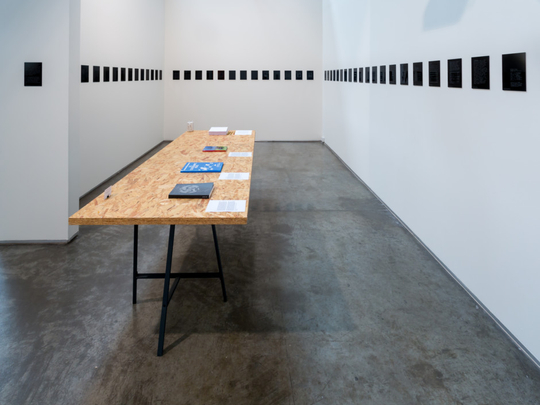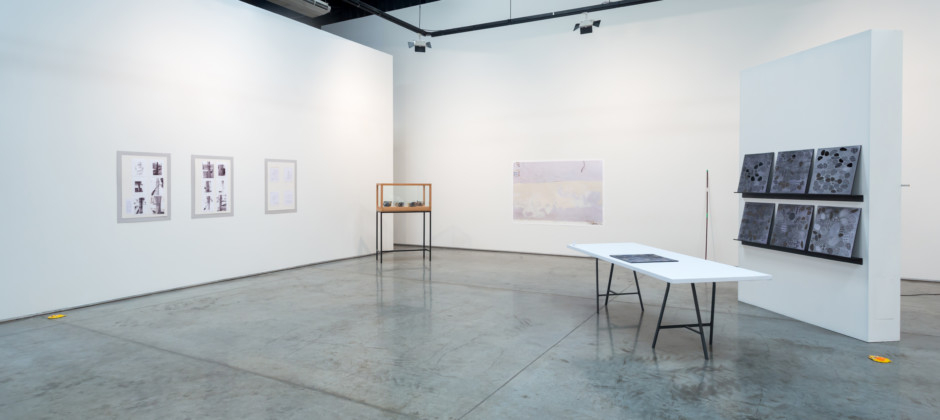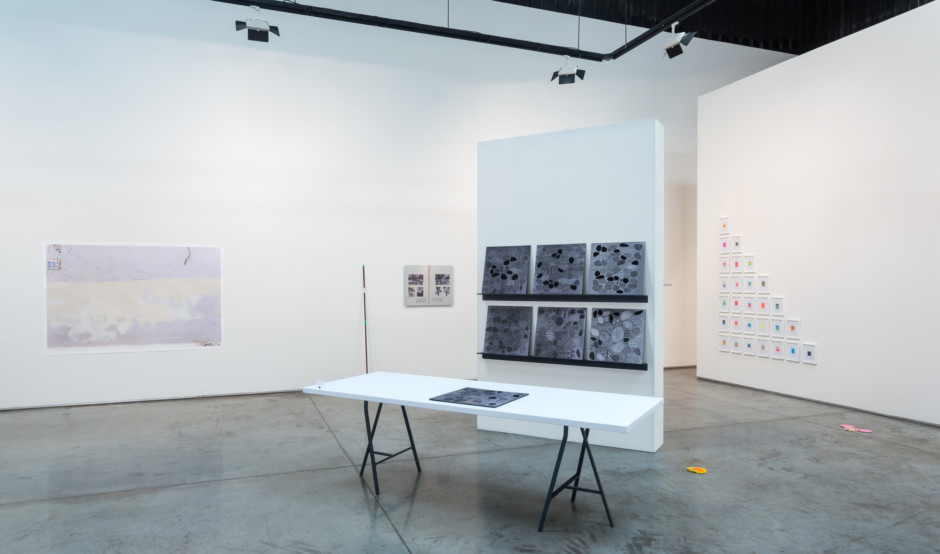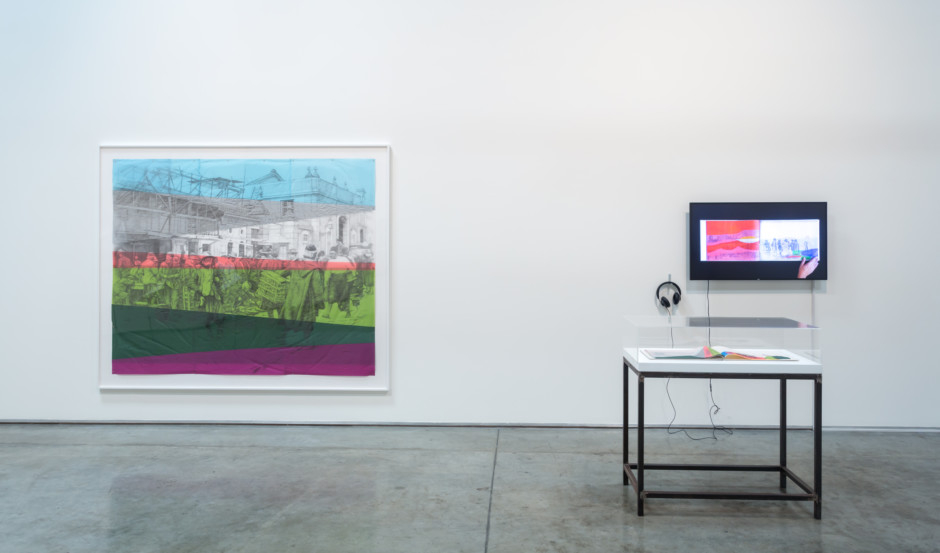
The summer exhibition at Gallery Isabelle van den Eynde is called Good Printing, but the show is not about displaying perfect prints produced by photography, lithography or other printing processes. Instead, curator Yasmina Reggad is interested in a playful exploration of the processes and technologies of printmaking. She has brought together works by 10 artists, who have a quirky and humorous approach to printing as a medium for producing and reproducing art.
“This show addresses the process of print making in terms of authenticity, reproducibility and the mechanisation of art making. But the artists are not on a nostalgic quest to recreate an original work of art. They want to celebrate the mistakes that can happen in the process of copying originals or reproductions, which lend originality to the prints. Whereas printmaking removes the artist’s hand from the production of the work, these artists have found various ways of putting their individual touch in the ‘prints’ they have created, including bypassing technology to make reproductions by hand,” Reggad says.
Aisha Khalid’s work, Name, Class, Subject, placed next to the entrance of the gallery gives visitors a clear indication of the show’s approach to the theme.
The Lahore based artist is presenting a limited-edition book, inspired by her childhood memories of the notebooks used in Pakistani government schools to teach children Urdu and English writing. Her book is produced from over 300 original two-sided paintings of ruled pages, painted in the traditional Mughal style of miniature painting, making each printed page unique. But she has also reproduced the printing errors in the lined pages that are commonly found in the mass-produced notebooks.
“Aisha has highlighted the mistakes in the printing of the different types of lines on the English and Urdu sides of the mass-produced books, using the bad printing as her inspiration. The work speaks about the process of art making as well as social and political issues in post-colonial Pakistan, such as the imposed hierarchy of a society shaped by a bilingual culture. At the same time, with the prints of her paintings and other surprising interventions inside the books, Khalid has transformed a cheap notebook into a work of art, which can still be used for writing. The work also reflects our desire to make art affordable to encourage young collectors, which is what printing in art is essentially about,” Reggad says.
Like Khalid, Turkish duo :mentalKLINIK were also inspired by a mass-produced printed product such as balloons shaped like cartoon characters. Their Airless series, features what look like deflated balloons, but are actually copper sculptures, with the distorted faces of cartoon ducks and mice carefully painted on them with acrylic colours.
The works, some of which are lying on the floor in the gallery, comment on our contemporary consumer culture; but in the context of the show’s theme, they highlight the fact that the identical mass-produced items assume unique shapes when they are deflated. The artists are also showing another series, Lazy Works, where they have used office materials such as sticky notes (post-its) and index cards to create artworks with repetitive patterns and deliberate mistakes.
Pauline Bastard is presenting a series of objects that look like analogue cameras, but are made from found objects collected from the streets and the UAE desert during her travels. The French artist’s cameras do not contain film imprinted with images of the places she has visited, but the debris that they are crafted from embodies the fragmented memories of those places.
Similarly, Dutch artist William Engelen’s installation, Quintet features a set of five handwritten musical scores, folded like accordions, and placed on note stands of different heights indicating the instruments they are meant for. Once again, although there is no performance happening, the set-up evokes the feeling of the sound, inviting viewers to reproduce the music in their imagination.
Rania Bellou has bypassed technology to reproduce images of a bygone era by hand. The Greek artist found a diary at a flea market, with notes from an unknown diarist narrating his emotional story of being separated from his childhood sweetheart, and then reunited with her 30 years later.
The artist did extensive research on the history of the period mentioned in the diary, the landscape of the places in the stories, and other elements. Using the stories shared by the diarist as her inspiration, she then produced a series of engraving-like drawings that seem to be precise copies of archival photographs from that time. She has also produced a book, inspired by a romantic poem in the diary, featuring 30 drawings on colourful tissue papers.
The artworks, which attempt to reproduce fleeting moments, feelings, memories and dreams, are almost perfect prints, without being prints, questioning the boundary between reality and illusion.
The show also includes a set of three works, Distance and Time, created in 1983 by late Emirati conceptual artist, Hassan Sharif. Rather than developing a perfect print, Sharif was interested in deconstructing the developing process. So, he devised a system to arrive at some random numbers, which dictated how far he placed the vertical lens enlarger from the photographic paper, and how long he left the film to develop. The resulting blurred, out of focus images express his thoughts, and creative process, showing us his inner world rather than his surroundings.
Other works in the show include a hand-woven Persian carpet modified with lithographs and threads by Iranian artist Haleh Redjaian; Lithuanian artist Eglé Budvytyté and Indian artist Sreshta Rit Premnath’s attempts to reproduce performance art with a vinyl record and photographs respectively; and Greek artist Ilan Manouach’s series of acrylic sheets etched with ‘tactigrams’, which are narratives in a universal tactile language, developed by the artist.
The show also includes an Expanded Printing Room, featuring new, often interactive works by the artists every week.
Jyoti Kalsi is an arts-enthusiast based in Dubai.
Good Printing will run at Gallery Isabelle van den Eynde, Alserkal Avenue until August 19.















